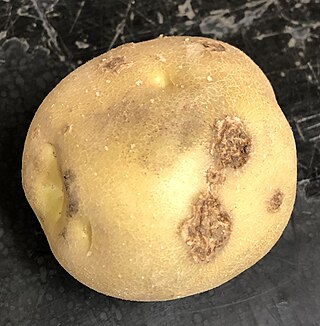
Agrobacterium is a genus of Gram-negative bacteria established by H. J. Conn that uses horizontal gene transfer to cause tumors in plants. Agrobacterium tumefaciens is the most commonly studied species in this genus. Agrobacterium is well known for its ability to transfer DNA between itself and plants, and for this reason it has become an important tool for genetic engineering.

Streptomyces is the largest genus of Actinomycetota, and the type genus of the family Streptomycetaceae. Over 700 species of Streptomyces bacteria have been described. As with the other Actinomycetota, streptomycetes are gram-positive, and have very large genomes with high GC content. Found predominantly in soil and decaying vegetation, most streptomycetes produce spores, and are noted for their distinct "earthy" odor that results from production of a volatile metabolite, geosmin. Different strains of the same species may colonize very diverse environments.

Streptomyces griseus is a species of bacteria in the genus Streptomyces commonly found in soil. A few strains have been also reported from deep-sea sediments. It is a Gram-positive bacterium with high GC content. Along with most other streptomycetes, S. griseus strains are well known producers of antibiotics and other such commercially significant secondary metabolites. These strains are known to be producers of 32 different structural types of bioactive compounds. Streptomycin, the first antibiotic ever reported from a bacterium, comes from strains of S. griseus. Recently, the whole genome sequence of one of its strains had been completed.

Liberibacter is a genus of Gram-negative bacteria in the Rhizobiaceae family. Detection of the liberibacteria is based on PCR amplification of their 16S rRNA gene with specific primers. Members of the genus are plant pathogens mostly transmitted by psyllids. The genus was originally spelled Liberobacter.
Streptomyces scabiei is a streptomycete bacterium species found in soils around the world. Unlike most of the 500 or so Streptomyces species it is a plant pathogen causing corky lesions to form on tuber and root crops as well as decreasing the growth of seedlings. Along with other closely related species it causes the potato disease common scab, which is an economically important disease in many potato growing areas. It was first described in 1892, being classified as a fungus, before being renamed in 1914 and again in 1948. Several other species of Streptomyces cause similar diseases to S. scabiei but other, more closely related species, do not.
Streptomyces avermitilis is a species of bacteria in the genus Streptomyces. This bacterium was discovered by Satoshi Ōmura in Shizuoka Prefecture, Japan.

Common scab is a plant disease of root and tuber crops caused by a small number of Streptomyces species, specifically S. scabies, S. acidiscabies, S. turgidiscabies and others. Common scab mainly affects potato, but can also cause disease on radish, parsnip, beet, and carrot. This plant disease is found wherever these vegetables are grown.

Bintje is a middle-early ripening potato variety bred in the Netherlands by the Frisian schoolmaster K.L. de Vries in 1904 from and marketed for the first time in 1910. The name of the potato, a diminutive of Benedict, was borrowed from one of his former students.
Streptomyces europaeiscabiei or is a streptomycete bacterium species that is associated with common scab in potatoes. Its type strain is CFBP 4497T.
Streptomyces stelliscabiei or is a streptomycete bacterium species that is associated with common scab in potatoes. Its type strain is CFBP 4521T.
Streptomyces reticuliscabiei is a streptomycete bacterium species that is associated with netted scab in potatoes. Its type strain is CFBP 4517T. It is considered to be part of a cluster together with S. turgidiscabies, however they cause different diseases, the former involved in common scab.
Pectobacterium atrosepticum is a species of bacterium. It is a plant pathogen causing blackleg of potato. Its type strain is CFBP 1526T. Its genome has been sequenced.
Pectobacterium wasabiae is a plant pathogenic bacterium that was first reported to cause disease on wasabi plants. A closely related species, yet to be formally named, also causes disease on potato. Unlike most Pectobacterium, P. wasabiae strains lack a type III secretion system. Its type strain is CFBP 3304T(=LMG 8404T =NCPPB 3701T =ICMP 9121T).
Streptomyces turgidiscabies is a streptomycete bacterium species, causing scab in potatoes. It has flexuous spore, the latter which are cylindrical and smooth. The type strain is SY9113T. It is almost identical to Streptomyces reticuliscabiei; however, they are considered distinct species given the diseases they cause are different.
Streptomyces puniciscabiei is a streptomycete bacterium species known to cause potato common scab disease in Korea. Its type strain is S77T. It has purple-red, spiny spores that are borne in simple rectus flexuous spore-chains.
Streptomyces niveiscabiei is a streptomycete bacterium species known to cause potato common scab disease in Korea. Its type strain is S78T. It has white, smooth, cylindrical spores that are borne in simple rectus flexuous spore-chains.
Streptomyces ipomoeae is a bacterium species from the genus of Streptomyces which has been isolated from rot from potatoes. Streptomyces ipomoeae produces thaxtomin C and ipomycin. Streptomyces ipomoeae can cause soft rot disease on sweet potatoes.
Streptomyces microflavus is a bacterium species from the genus of Streptomyces which has been isolated from soil. Streptomyces microflavus produces nemadectin, fattiviracin A1, milbemycin and deoxyuridines. Streptomyces microflavus also produces the ionophore valinomycin. Streptomyces microflavus is also known to cause potato common scab disease in Korea.
Streptomyces seoulensis is a bacterium species from the genus of Streptomyces which has been isolated from soil from Korea. Streptomyces seoulensis produces lipoamide dehydrogenase.
Streptomyces vietnamensis is a bacterium species from the genus of Streptomyces which has been isolated from forest soil in Vietnam.





